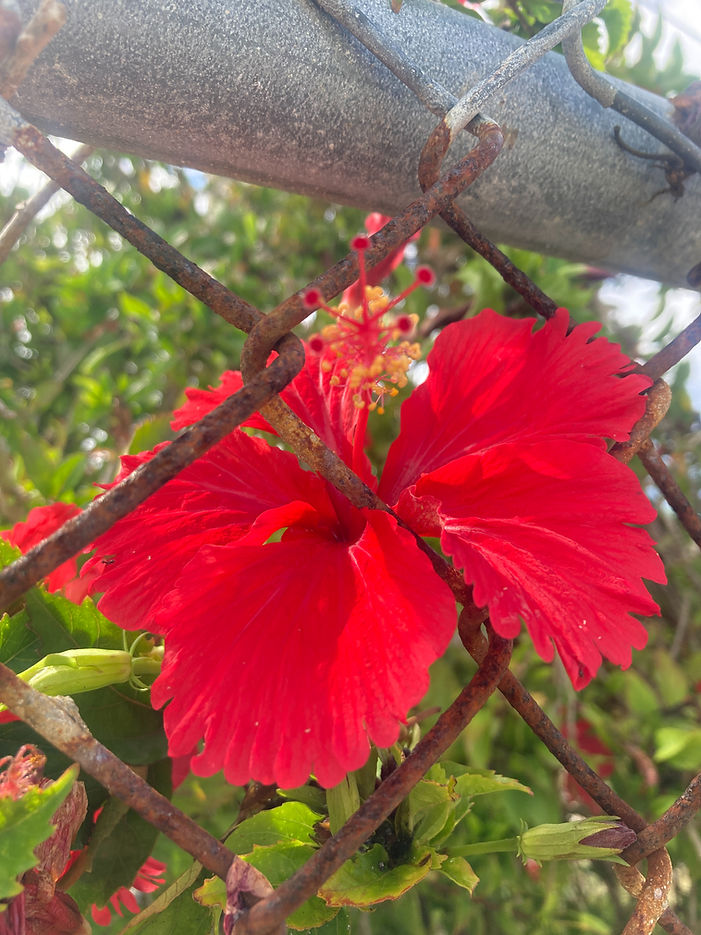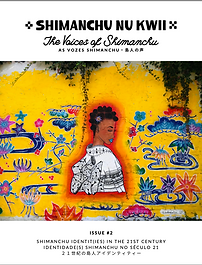Alexyss McClellan-Ufugusuku



Lex is a University of California President's Post-Doctoral Fellow (PPFP) in the History Department at the University of California San Diego
She teaches and researches on the history of the Ryukyu Islands, the U.S. and Japanese empires, and the confluence points of Indigeneity, diaspora, and militarization.
About:
Lex is a mixed-race shikkē nu Uchinaanchu winagu (Indigenous, diasporic Ryūkyūan woman from the island of Okinawa). Proudly from South Bay, San Diego, Lex's academic research interests swirl around the intersections of Ryūkyūan history, diasporic roots and routes, and militarization in the islands that persists today. She earned her PhD in History— with a Designated Emphasis in Critical Race & Ethnic Studies— from the University of California Santa Cruz. As of Fall 2025, Lex will be a UC President's Postdoctoral Fellow (PPFP) in the History Department at the University of California San Diego.
As an Uchinaanchu Indigenous Ryūkyūan woman, I was raised learning my family's own roles and experiences with migration, empire, and geopolitical reordering following World War II. My family's own roots are in Haebaru (Tsukazan) and Yaese (Shitahaku) but because of diasporic routes, my grandmother and her siblings were all born on the island of Tinian in the Northern Mariana Islands. It was her experience of living in an internment camp for two years before being repatriated to Okinawa by the U.S. military that led to my interest in what other ways that empire(s) make themselves known in Ryūkyūan peoples' histories and stories.
My current book project: Defining USCAR: Islands, Identity, and Indigeneity in the Ryūkyū Islands, interrogates the ways in which the Islands and their inhabitants had their legal status defined (or not) by the United States Civil Administration of the Ryūkyū Islands. My dissertation research was generously funded by multiple fellowships at UCSC and the University of California Office of the President, and I have presented conference papers related to my book project and other facets of Ryūkyūan Studies. As a promise to myself, for every academic conference paper I give, I give at least one community presentation as well.
As a scholar of my own community and of my ancestral islands, my sukubun is to my community and islands and as such I regularly attend and submit materials to various meetings of the United Nations, including the United Nations Permanent Forum on Indigenous Issues and the Expert Mechanism on the Rights of Indigenous Peoples (amongst others). For these meetings I represent ACSILs, which is an Indigenous Peoples Organization committed to Ryūkyūan Self-Determination; this includes the right of shikkē nu Rūchūnchu (diasporic Ryūkyūans) to participate in conversation about the future of our islands even if we are not citizens of Japan.
Since 2014, I have been involved with the Okinawa Memories Initiative (OMI) based out of UC Santa Cruz. OMI is a public history project with a team of faculty, staff, alumni, graduate, and undergraduate students. OMI employs methodologies of experiential learning and community service to teach students about the rich history of Okinawa both in the Ryūkyū Islands and abroad. I will continue working with OMI during my time at UC San Diego. You can read more about OMI and our work here: https://omi.ucsc.edu/about/
Recent conference presentations and In The News
Plenary Speaker at Feminism and Intersectionality in Okinawa 2025
(Okinawa Institute of Science and Technology)
"Women's Work:" Ryūkyūan women scholars in the U.S. academy
Decolonizing Futures Conference in Ryūkyūs/ Okinawa
Centre for Environmental and Minority Policy Studies (CemiPos)
"Japan's Alola:" Defining Okinawa's Hawaiian image in the Pokémon Company's 2022 PokéLids campaign
Native American and Indigenous Studies Association Annual Conference 2025
Panel: Articulating a modern Ryukyuan methodology: Confluences of Indigenous studies, diaspora studies, and demilitarization

The Indigenous World 2025
page 234

「PFASで長期的な健康被害を懸念」米軍による基地被害、国連で訴え 琉球独立学会
https://ryukyushimpo.jp/news/entry-1545333.html
Teaching
As a scholar of the Ryūkyū Islands, my own training has been geographically situated in East Asia and the Pacific but is heavily influenced by American Studies and Indigenous Studies, all of which are reflected in the courses I have taught.
I benefitted immensely from the team at UC Santa Cruz's Teaching and Learning Center, and was selected as a TLC Graduate Pedagogy Fellow in 2022. Additionally I was a Graduate Student Summer Residency Fellow at the National Humanities Center in 2020. As a result of these and more certificate and training opportunities, I was an Instructor of Record four times while at UC Santa Cruz, the following are the courses that I designed and taught.

History and Memory in the Ryūkyū Islands
This is a course on modern Ryūkyū Islands history—a small place with big significance. Today the islands are mostly known as Okinawa, the name of the largest island in the archipelago. In this course we re-think world history from the perspective of a small place, where people live in a world not of their choosing and navigate the space between global superpowers in their day-to-day lives. Typically, world history is taught from the perspectives of competing global powers. But what does it mean to live in a place between these powers? Okinawa’s position between China, Japan and the U.S. offers a unique perspective on life between empires as well as the Ryūkyūs' own unique history.
This course approaches this history through a diverse offering of primary sources across different mediums. By using the many different types of primary sources that historians use— and the different theoretical approaches to each medium— this course includes archival documents, maps, photographs, oral histories, food, tourism, music and even sound as source material.

The Japanese Empire 1868-1945
The Japanese empire often goes untaught or acknowledged in global histories of imperialism. Though short lived in comparison to empires such as the British or French, the Japanese empire has legacies that still affect cultural discourses and attitudes throughout Asia and the Pacific today. This course primarily looks at the Japanese empire prior to 1940, how Japan acquired its colonies, and the policies that were enacted in those places.
The course follows a chronological order beginning with Hokkaido and Okinawa, moves through the war acquisitions of Taiwan, Sakhalin, and the Liaodong Peninsula, and into the outright colonization of Korea. The course ends with a discussion of international politics and world events by looking at Japan’s being awarded the South Sea Mandate, and begins to set the stage for Japan’s path to war. The course is designed to merry primary sources and news coverage of the legacies of Japanese imperialism today, with secondary source material and films.
Image of the Fifth Industrial Exhibition in Osaka, 1903 https://www.oldtokyo.com/5th-national-industrial-exhibition-osaka-1903/

The U.S. Military in Asia and the Pacific: Power, Pollution, and Protest
This course is a survey of U.S. military bases and influence in the Asia Pacific Region since the end of the Second World War. Using the geographic scope of PACOM (Pacific Command) the course covers an area including Japan, Guam, Hawai’i, and Korea, among other places. There remains a long history of U.S. presence in and across the Pacific Ocean; sometimes this presence is in the form of U.S. soldiers stationed on bases abroad, sometimes this presence is landscape altering in the form of nuclear testing. In this course, student are introduced to key themes in the creation of “America’s Lake,” as well as movements of resistance against the U.S. empire. Designed to be lower-division, this course has three main learning objectives:
-
Compare and contrast: not all places with U.S. bases are the same. Students will learn about the different circumstances between states, territories, and foreign countries that house U.S. military personnel.
-
Primary Source Materials: students will read and critically analyze Status of Forces Agreements for various countries in the region.
-
Public speaking: students will work in groups of three to create a final project that will be presented in the last week of class.
Writing (selected)
FORTHCOMING “Okinawa when you least expect: encountering intergenerationally traumatic material in Minneapolis museum exhibits.”
In UchinaAmerican: Anthology of Okinawan American Art and Literature. Edited by Laura Kina, Wesley Ueunten, and Lee Tonouchi.

"Core readings by Shimanchu in Academia"
In Shimanchu nu Kwii. Volume 1
Issue 2.

"Shikkee nu Uchinaanchu roles, responsibilities, and positionality in repatriating Ryūkyūan ancestral remains"
In Tou i mudusa na! Washita Ruuchuu uyafaafuji nu funishin. Edited by Matsushima Yasukatsu and Teruya Midori. (Naha): 琉球館 (Ryūkyūkan) 2025.

Lacrosse
During my graduate tenure at UC Santa Cruz I also worked as the Head Coach for the UC Santa Cruz Intercollegiate Women's Lacrosse Team. I held this role from 2018 through completing my doctorate in 2025.
During my seven seasons as Head Coach, I oversaw the team through the transition from Covid, and in the four successive seasons we clinched the WWLL Northern Conference bid three times, competed in WWLL regional championships all four seasons, and played in the WCLA National Tournament in 2022.
In 2022, I was named the Western Women's Lacrosse League Coach of the Year.
During this time I also served as an Assistant Coach for the Pacific Collegiate School's Boys Lacrosse Team. During my seven seasons (2017-2024) I was the only consistent woman coach in a league is nominally for boys but that includes girls, nonbinary, and trans athletes. Between these two coaching roles I became a better and more compassionate educator and attribute coaching to my pedagogical approach today.
